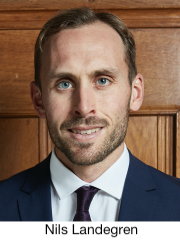“Ho ho ho. Come quietly, it’s a fair cop!” (Translation from the English: Ha ha! We’ve caught you red-handed in a criminal act. Best come along quietly to the police station. Don’t make a fuss”!)
Usually it takes years, or even decades, before the lies and abuses of Big Pharma show up. Meanwhile, the drug company has made a killing in sales and doesn’t care. Sometimes there’s even a fine of a few million dollars, even a few hundred million, as with Merck and Vioxx. But when sales are in the $billions, why should they care?
This time though, the fraudsters must have been shocked to be discovered in the very act, by an international consortium. They probably thought they had years to exploit the scam. So what’s going on?
A group of scientists from leading institutions is questioning the findings of a prominent immunology article linked to a strategic drug development partnership potentially worth up to $183 million (164 million euros). Follow the money, eh?
The original article, published in the journal Cell in 2016, describes studies of the immune systems of patients with rare autoimmune (APS-1). The disease results from mutations in the autoimmune regulator (AIRE) gene that in healthy people plays a role in training immune cells not to attack the body’s own tissue.
Even if you don’t quite understand the gobbledegook, understand this: it could open a doorway to widespread treatment of autoimmune diseases and, since autoimmune diseases are now so common, this means LOTSA MONEY for Big Pharma.
Never wanting to earn an honest $billion, when a crooked $10 million is out there, Big Pharma, of course, plumps for crime, every time!
This is how it unfolds…
In an article published in the journal eLife last month, scientists from institutions that include the Karolinska Institute in Sweden, the University of California SF, Stanford University, and the National Institute of Allergy and Infectious Diseases report that they attempted to replicate some of the results from the 2016 Cell article and were unable to do so.
Now I had said many times in my reports that the Karolinska Institute in Sweden is above reproach. I don’t mean they never make mistakes. But they don’t LIE prodigiously like American centers of science. So I trust that Karolinska.

The Karloinska Institute. Stockholm, Sweden
Therefore, when they, and the other three study centers, say they “can’t replicate” the published findings, it almost certainly means something bogus is going in. YES, MEDICAL JOURNALS DO PUBLISH COMPLETELY FALSE PAPERS (OFTEN), SOMETIMES EVEN WITH INVENTED “RESEARCHERS”!
Big Pharma’s dirty fingers are in there, always, to the point where published science has almost meaningless credibility; you can choose to believe it or not believe is, as you like. But if you openly criticize a study, they will probably arrange for you to quietly “disappear” [No, not the concrete shoes! But your article will be quietly withdrawn]
Now they have a problem; 3 world-class research centers say “It looks like you’re lying”! (only they put it politely and say “We can’t replicate your findings.”) That’s going to be hard to bury.
They challenge two of the original article’s findings: that patients with APS-1 produced a much wider range of antibodies against their own bodies’ tissues than previously described. Secondly, that the antibodies “discovered” seemed to protect against diabetes. Again, this is a HUGE market. Diabetes and pre-diabetes are on the rise to the point where over 50% of the US population has one or the other. And as I reported recently, an incredible 88% of Americans did not have full healthy markers for glucose metabolism.
Anyway, these possibly-illusory antibodies became the focus of a development partnership between the France-headquartered pharmaceutical company Servier and German biotechnology company ImmunoQure, said ImmunoQure cofounder Adrian Hayday, PhD, a professor and researcher at King’s College London and corresponding author of the Cell article.
Servier agreed to pay ImmunoQure up to €164 million ($183 million), which includes an upfront payment of an undisclosed amount and additional payments at milestones in the development process, plus royalties on net sales if the antibody makes it to market. Sounds like a bribe to me! Who wouldn’t be careless with the results, when there is nearly $200 million on the table, plus pickings.
Despite the new challenge, a Servier spokesperson said the company’s internal data confirm the importance of the supposed antibody pathway in autoimmune diseases, as well as the specificity and neutralizing activity of the antibody cloned by ImmunoQure. Well, they would say that, of course.
Challenging a “Landmark” Article
On the point about the number of antibodies against their own body’s molecules that APS-1 patients are supposed to have developed, the challenging scientists make the case that the statistical analysis in the Cell article was skewed to identify significantly more antibodies in the serum of case patients than of control patients.

“We could show that using random data [meaningless figures], we got basically the same result they did,” said lead author Nils Landegren, MD, PhD, of the Karolinska Institute in Stockholm, Sweden. “We have a very strong case their results are false.” (my addition in brackets).
Landegren and colleagues also ran experiments to test whether the prevention of diabetes theory held water. It did not.
“We did our best using an established method, using positive and negative controls showing the expected result,” Landegren said, but they could not see any difference between patients who had type 1 diabetes and those who did not. It will be important for other research groups to try to replicate the experiment in future studies and to see how they fare, Landegren said.
That’s good science.
Hayday said his group used the statistical analysis method they did because he was more concerned about ruling out false negative results than false positives when looking for antibodies expressed as “private reactivities” in a few patients, not the cohort as a collective group. That’s BAD science…
Translation: bend the result in favor of the findings we want, rather than allowing “false” negatives to screw it up. But to me, that’s as good as a confession of malfeasance. Since he’s not supposed to know before he starts what the results will be, why would he be skewing the results away from a negative finding?
Hayday sees the difference in statistics as a difference in approach: “When you undertake a statistical treatment of data, there is no silver bullet, you have to use what makes sense.”
In the end, it got dirty. Hayday accused the other teams of “shoddy” work! Sounds like someone caught red-handed, doesn’t it? When four other study centers, who have no academic or financial bias factors, say his results aren’t valid, who would you side with?
Now others have stepped in. London-based pharmaceutical company AstraZeneca and the small French biotech Neovacs, both studies failed their primary endpoints. These recent clinical data are “mixed at best”, they said.
Access to ImmunoQure’s website currently requires login credentials, but Hayday said that that is unrelated to the recent publication. Oh yeah! The website is being redesigned and will be back up again in about 10 days, he said.
Is this starting to stink a little bit, to you?
One of the scientists who reviewed Hayday’s work from 2016 rejected the Karolinska team’s criticism and spoke of a “landmark” paper. Another scientist reviewer disagreed: “This appears to warrant a revision to the original conclusions in Cell…”
As for the contested statistical analysis, one reviewer wrote that Landegren’s and colleagues’ concern is “100% warranted.”
Incidentally, the authors of the new critique originally submitted their manuscript to Cell, but it was rejected without an explanation, Landegren said.
And that’s just about where the “science” ends, folks. Quibbling, disagreement, almost certain malfeasance, if not fraud, and name calling.
I’m glad I’m out of it. I treated autoimmune diseases with far higher positive outcomes for decades, talking with Mother Nature, prescribing better diet, chemical unburdening, parasites, dysbiosis and sometimes a little psychological “lift”!
Food allergies and environmental chemical sensitivity were by far the most common mediators of autoimmune disease.
I thought I’d just give you a heads up on how they do “science” these days,

Prof. Keith Scott-Mumby
The Official Alternative Doctor
Conflict of interest: Landegren has disclosed no relevant financial relationships. Hayday, not surprisingly, reports holding equity in ImmunoQure, as do other coauthors of the formal response!
Sources:
1. eLife. Published online June 27, 2019.
The post Caught Red-Handed Scamming and Faking “Science” appeared first on Dr. Keith Scott-Mumby.
